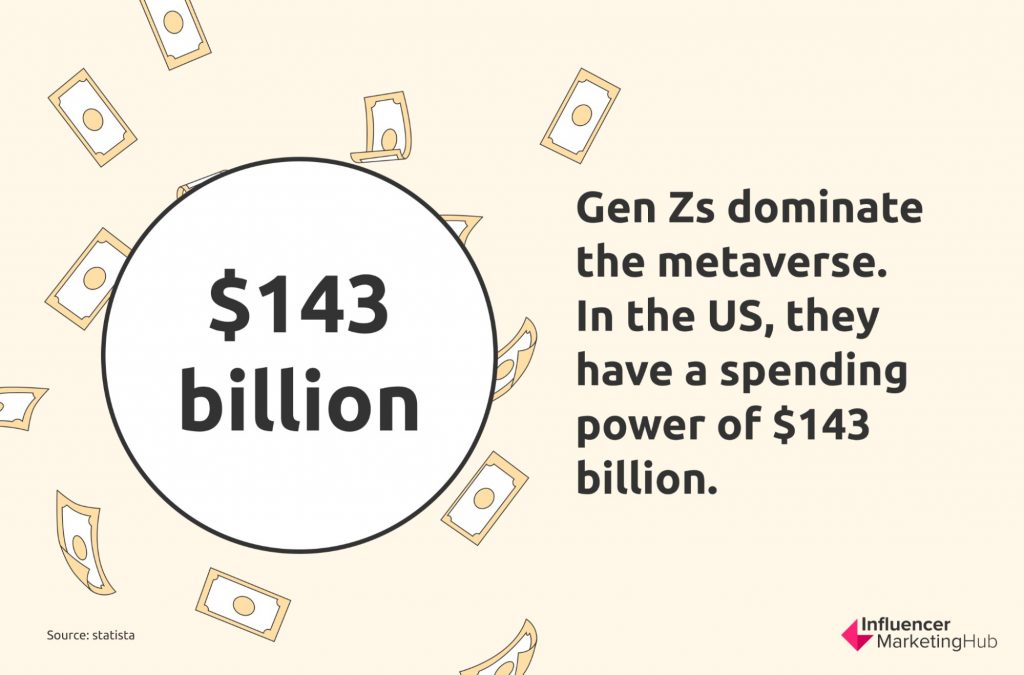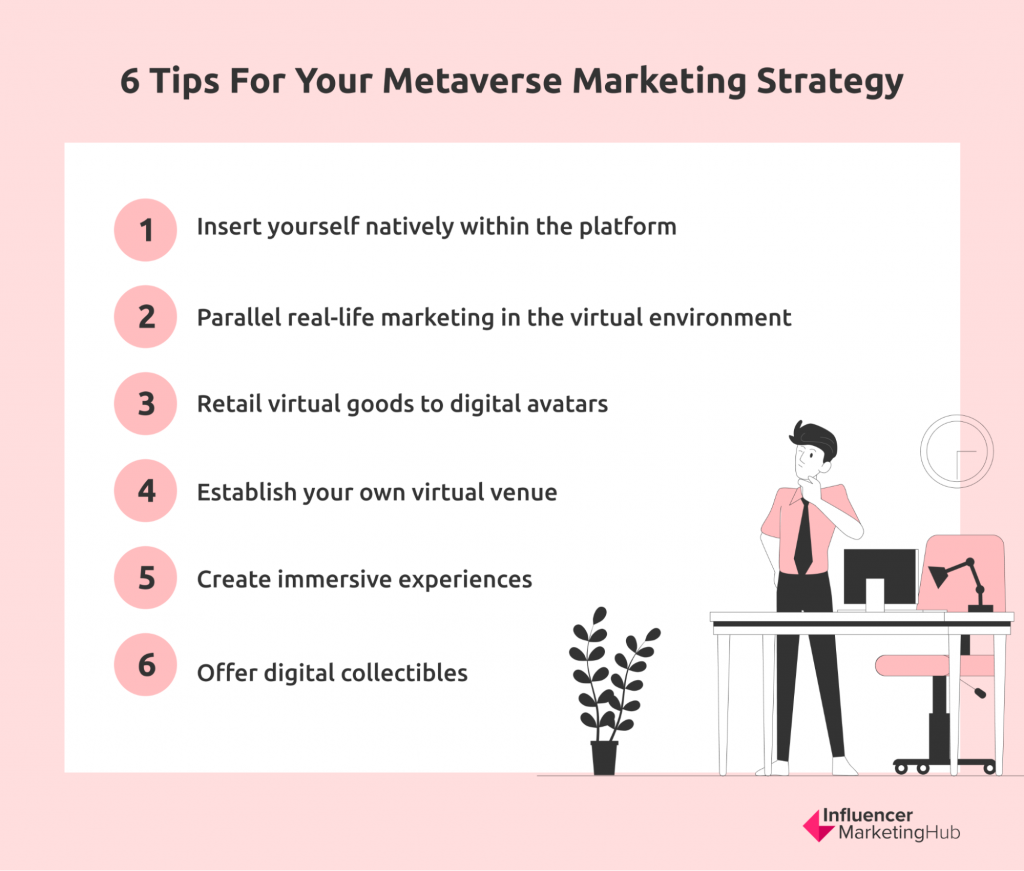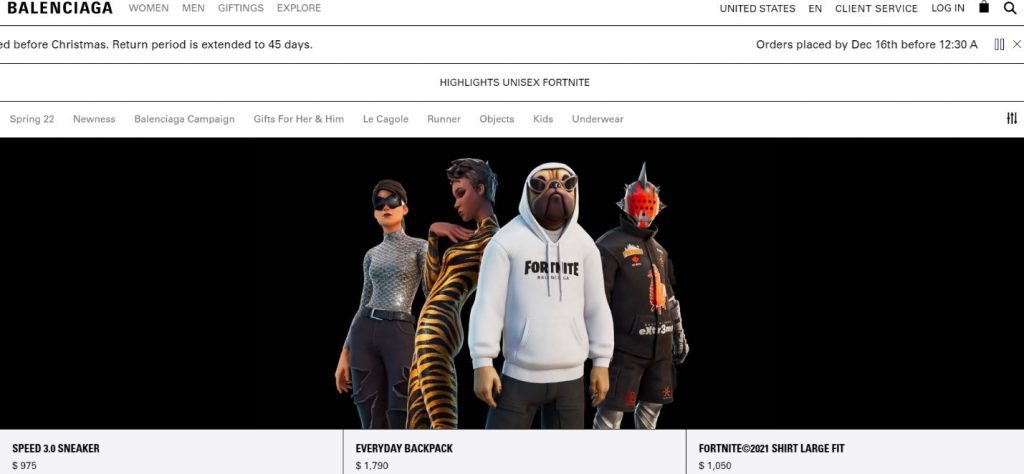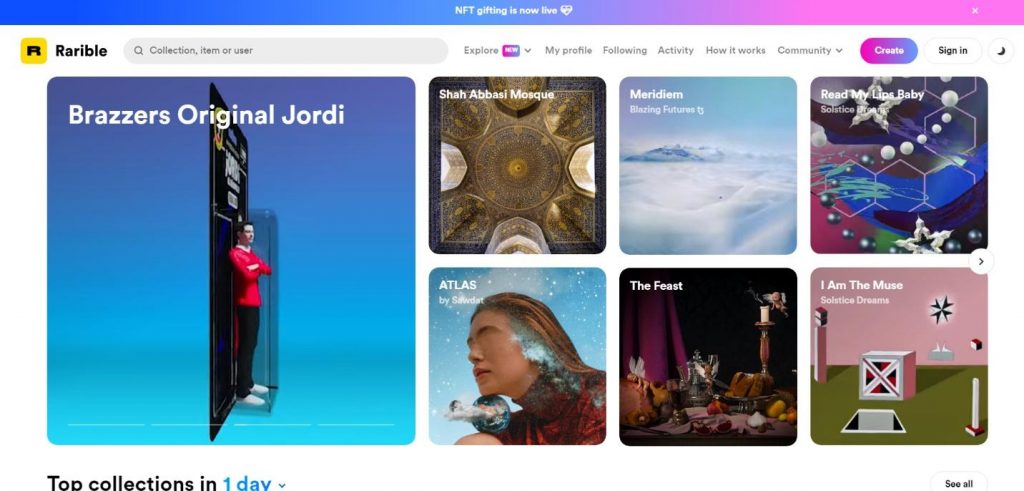2021 saw an increased focus on the metaverse. From luxury items and limited-edition collectibles to digital concerts, dozens of brands are venturing into the next iteration of the internet.
Although the metaverse is still in its infancy, it will clearly shape the future of business and marketing. How should you make your move? In this article, we’ve compiled the best metaverse marketing strategies that you can use, including examples that you can learn from.
6 Metaverse Marketing Strategies with Examples
What Is the Metaverse?
Essentially, the metaverse is a parallel virtual world. It consists of multiple interoperable online spaces, where people (as digital avatars) can shop, trade, travel, socialize, and interact with one another. The goal is to offer a hyper-real alternative world for the one that you currently live in.
A fully realized metaverse is a combination of multiple technologies, such as augmented and virtual reality, videos, and 3D avatars. While its actualization can take a few years, you can already see aspects of it in online game universes, like Fortnite, Roblox, Animal Crossing, and Minecraft.
Why Should You Market in the Metaverse?
The age of digital dependency has transformed consumer behavior. Partly because of the coronavirus pandemic, more people are shopping, working, playing, and learning online. The metaverse promises a “phygital” (physical and digital) solution. It seeks to blur the line between physical and virtual reality and change how we experience the world.
For companies, this presents an opportunity to reach new audiences, improve consumer confidence, and explore a potential revenue stream. Roblox, for one, has 200 million active users, who spent $319 million on in-game currency in just the second quarter of 2020. Remarkably, 67% of the online gaming platform’s demographic fall below the age of 16.
With Gen Zs dominating the metaverse, we can’t stress enough their value as consumers. In the US, they have a spending power of $143 billion, and experts predict that it will surpass that of millennials and boomers by 2030.
Overall, the metaverse is brimming with opportunities for businesses. Top brands have tried their hand at it, and so should you. These best metaverse marketing strategies can help you glean some insights.
Top Metaverse Marketing Strategies
1. Insert yourself natively within the platform
By nature, advertising is interruptive. While the five-second ad at the beginning of a YouTube video can stop people in their tracks, it can also get annoying. On the other hand, inserting yourself naturally in the platform allows you to engage with users without disrupting their playing experience.
Using native in-game advertising is one way of doing this. Coca-Cola, Samsung, and Volkswagen all have virtual billboards within video games like Football Manager and Hyper Scape. The in-game advertising platform Bidstack revealed that these ads enhanced gameplay realism for 95% of players and increased purchase intent by 12%.
Here are some tips that can help you create in-game ads:
-
Consider your target audience
Which motivators does your audience respond to? Would you consider them casual, midcore, or hardcore gamers? How you categorize your target audience would significantly impact your in-game campaign.
-
Choose the right video gaming platform
Whether it’s mobile, PC, console, or streaming, your platform should increase your reach while still aligning with your brand. Mobile games, for example, can reach more casual gamers, while PC and console games can gain more traction with midcore gamers.
-
Select your format
Aside from virtual billboards in digital sports stadiums, in-game apps also include video, music, and banner ads. Choose a format with which your product can identify. Recording artist Nas, for example, used in-game audio ads to promote his album “King’s Disease II.” It saw a 1,275% click-through rate relative to the typical rate of traditional in-game banners.
In-game advertisements have their advantages and disadvantages:
Pros
- Increased views and engagement
- Campaign control and management
- Enhanced user experience
Cons
- Lack of available performance data
- Few complementary video game platforms
2. Parallel real-life marketing in the virtual environment
Transitioning into the metaverse doesn’t necessarily mean that you have to do everything differently. A good starting point is to replicate what you offer in real life in the parallel virtual world. It’s not only a natural method to enter the metaverse but also an authentic way for users to notice your brand.
An example of this is Deliveroo’s marketing campaign on Animal Crossing. The online food delivery company deployed virtual riders in the game for multiple island-wide deliveries. Players received not only a surprise delivery on their virtual island but also a promo code that they could activate in real life. Within the first hour alone, Deliveroo’s marketing campaign gained three million in-game engagement.
Similarly, introducing your real-life cause in the metaverse can increase your brand engagement. Hellmann’s, a mayonnaise brand, brought its commitment to reducing food waste to Animal Crossing as well. The company created its own virtual island and invited players to donate their virtual spoiled turnips for a cause. This helped Hellmann’s donate 50,000 meals to FareShare, a food waste charity.
There are also benefits and limitations in doing this metaverse marketing strategy.
Pros
- Increased brand engagement and recognition
- Immersive user experience
- Reduced supply chain cost and risk
Cons
- More time spent in planning the campaign
- Heavy marketing effort prior to implementation
3. Retail virtual goods to digital avatars
Online identities are crucial in the metaverse, where avatars represent people. A study found that 92% of people value customization in creating their virtual avatars. Like in real life, people in the 3D environment are spending a lot of money on self-expression.
Because of this, the direct-to-avatar (D2A) economy is emerging. It allows companies to sell and retail their virtual products directly to avatars. Naturally, fashion brands are taking advantage of this opportunity. Balenciaga has partnered with Fortnite to design virtual outfits, accessories, and weapons that players can purchase for their avatars. Meanwhile, Gucci has sold a digital bag on Roblox for $4,000.
Here are some tips to help you penetrate the D2A market:
-
Partner with in-platform creators
Teaming up with online game universes like Fortnite or League of Legends will help you create virtual possessions that can naturally fit into the gaming experience. Otherwise, you can use 3D and AR platforms with open marketplaces to create wearable and tradeable digital garments. The Fabricant Studio is a viable choice if you have no prior knowledge of 3D software.
-
Experiment with AR
Augmented reality or AR is set to change shopping experiences by allowing users to visualize clothing products in real time. A report on the impact of AR on retail shows that 61% of users prefer to shop in stores that offer AR. Earlier this year, Gucci made headlines not just by selling digital shoes to avatars but also by giving buyers a chance to wear those shoes with AR.
-
Turn your virtual good into an NFT
NFTs or non-fungible tokens can trace the production and distribution of your virtual apparel. This can prove authenticity, which helps build consumer confidence. An NFT art marketplace like Rarible can help you turn your virtual goods into an NFT, put it up for sale, and even send royalties to your digital wallet.
There are also benefits and drawbacks to using D2A.
Pros
- Unique shopping experience
- Long-term sustainability
- Faster supply chain
Cons
- Costly development
4. Establish your own virtual venue
Going digital shouldn’t stop you from opening a shop. A virtual 3D store, museum, or island can establish your presence in the metaverse and build strong emotional connections with your customers. You can offer tours, virtual try-ons or try-outs, and interactive 3D product exhibits.
Sentosa Development Corporation brought Singapore’s State of Fun to Animal Crossing, while Fila built their own shop within the same game. Meanwhile, General Mills’ web-based tailgate experience earned more than 500,000 impressions across traditional and social media channels.
To create your own virtual establishment:
-
Team up with AR/VR platforms and designers
Define your visual environment with experienced platforms. A virtual store platform like Obsess, which helped Ralph Lauren create its virtual boutique, can help you every step of the way.
-
Determine the size and quantity of your 3D shop
Why settle for one when you can create two or more virtual shops? Hyundai Motors launched five theme parks on Roblox to introduce younger consumers to Hyundai’s products and future mobility solutions. On the other hand, Net-A-Porter created an entire island on Animal Crossing to feature its 3D headquarters, photography studio, and editorial room.
-
Make it interactive
Interactive marketing can increase your chances of meeting customer needs. A great example is the Gucci Garden virtual exhibit on Roblox. This interactive environment allowed Gucci fans to explore themed rooms and immerse and interact with various digital clothing and accessories. Visitors can even purchase exclusive, limited-edition avatar items on the Gucci Garden virtual store.
-
Launch on your chosen channel
Many brands launch their shop on metaverse spaces like Animal Crossing and Roblox because these platforms already have an engaged audience. But launching your shop on your own virtual site can help you build a first-party data strategy.
Note the following advantages and disadvantages of creating a virtual venue.
Pros
- Immersive customer experience
- More brand exposure and interaction
- Increased audience reach
Cons
- Long and costly development
- Inability to measure ROI
5. Create immersive experiences
Experiential marketing is one of the most important drivers of customer engagement. Studies show that brands who focus on building experiences gain 25% more brand loyalty than those who don’t. Offering an immersive experience takes audiences out of their comfort zone. This can impact their perspective of your brand and help you create long-lasting bonds with them.
Here are some immersive experience campaigns that you can use in the metaverse.
-
Live concert performances
Virtual music events allow audiences to engage and interact with your brand. Rapper and producer Travis Scott performed a virtual concert in Fortnite as a 3D avatar, drawing 12.3 million concurrent players. Similarly, The Weeknd (as a digital avatar) performed a live version of “Blinding Lights” on TikTok, where real-time comments appeared as flashing lights and fireworks in the background.
-
Massive interactive live events
Involving audiences in your storytelling process could also drive massive growth. Genvid Holdings’ Rival Peak is a great example. Part-game, part-TV show, the live event invited players to determine the fates of 12 AI characters. It streamed 24/7 globally and garnered 200 million engagements and surpassed 100 million minutes watched.
-
Advergames
In a nutshell, advergames are ads in the form of a game. It’s an innovative method for creating buzz around your brand. With this strategy, audiences will discuss not just your product but also your game. An example is Tourism New Zealand’s Play NZ campaign. The adventure game allows players to visit various sites and attractions in a 3D New Zealand.
Offering an immersive experience also has its pros and cons.
Pros
- Increased reach and engagement
- Suitability for all types of business
- Long-term results
- Improved customer loyalty and referral
Cons
- High costs
- Promotional campaign requirement
- Demand for creativity
6. Offer digital collectibles
Humans are innate collectors, and that won’t change in the metaverse. In these virtual spaces, collectibles use digital assets called NFTs. This means that original ownership of a collectible, such as digital art, music, or apparel, is encrypted and unchangeable unless the owner sells it to another.
Although the long-term value of NFTs remains uncertain for now, brands still find them attractive because of the marketing opportunity and high returns. For example, resales of Budweiser’s rarer NFT beer have gone up for more than $20,000. Meanwhile, a digital Derrick Rose layup NBA Top Shot card costs $1 million.
Here are some ways that you can offer branded collectibles:
-
Bundle with exclusive benefits
Customers buy products or services because of their benefits. A unique deal would make your collectible not just more attractive but also more profitable.
For example, the Budweiser NFT cans are an entry key to Budverse, a mystery collectible. The collection sold out in an hour, and its resale price increased. Meanwhile, Kings of Leon’s special edition NFT album includes enhanced media and a limited-edition vinyl. The major rock band has generated $2 million from sales of this album.
-
Use it as a reward
Rewarding audiences for purchasing your product gives them more reason to engage with your brand. NBA’s Dallas Mavericks, for example, is giving away NFTs to fans who attend home games. Fans can keep, sell, or trade these cards. For collecting special groups, they can even win special rewards.
-
Package with physical items
NFTs can give collectors the satisfaction of exclusivity, while a physical product can give them something to show off. Luxury watchmaker Longines listed a watch with 45 limited-edition NFTs, while luxury fashion house Burberry sold out 1,000 special edition scarves that came with an interactive NFT deer.
Digital collectibles also have good points and bad points.
Pros
- High returns
- Potential for a quick profit
- Ownership of product
- Brand-building opportunity
Cons
- Time-consuming
- High-risk
- Steep financial barrier









